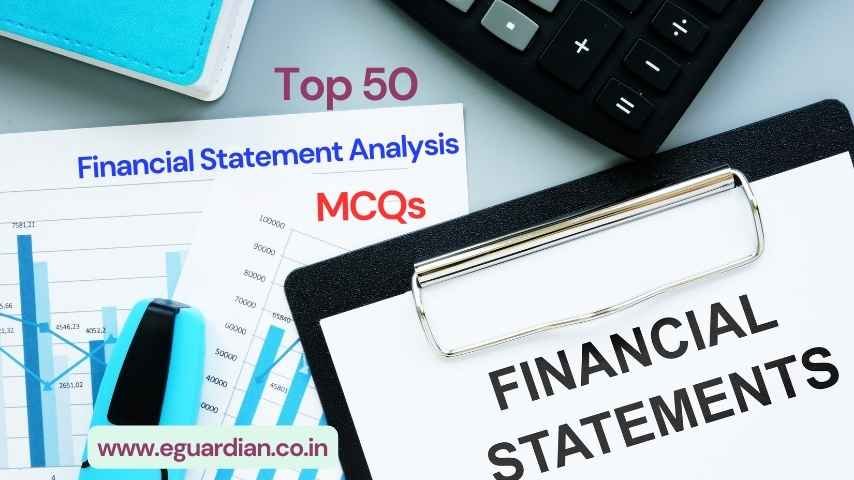Financial Accounting MCQs with Answers pdf – MCQ Accounting for preparation of academic and competitive exams of various Institutes.

Financial Accounting MCQs with Answers
1. The customer’s account with the bank is called ___.
Ans: Bank Statement/Passbook
2. In the bank column of the cash, the cheques deposited are entered on the ___ book.
Ans: Debit side
3. Bank Reconciliation statement is prepared to ___ the bank balance as shown by the cash book and the bank statement.
Ans: Reconcile
4. Cheques issued are posted on the ___ side of the bank column of Cash Book.
Ans: Credit
5. The credit column of the passbook should be equal to the ___ column of the cash book and the debit column of the passbook should equal to the ___ column of the cash book, if there are no differences.
Ans: Debit, Credit
6. Bank credits the firm’s account as soon as it receives cheques from the firm. (True / False)
Ans: False
7. Bank charges are entered in the passbook first. (True / False)
Ans: True
8. Banks make certain payments on behalf of the customer under his standing instructions.
(True / False)
Ans: True
9. In the case of cheques issued but not encashed, the balance of the passbook will be less than the balance of the Cash Book. (True / False)
Ans: False
10. Direct deposits in the bank by a customer would increase the balance shown by the Pass Book. (True / False)
Ans: True
Instruction for Ques No. 11 to 16
From the following transactions, please specify which transactions are to be added or deducted to the cash book balance given: Mention “A” if to be added and “D” if to be deducted:
11. Interest allowed by Bank ( )
Ans: A
12. Cheques deposited with the bank and dishonoured ( )
Ans: D
13. Cheques issued but not encashed ( )
Ans: A
14. Bank charges ( )
Ans: D
15. Insurance premium paid by bank ( )
Ans: D
16. Dividends on share collected by a bank ( )
Ans: A
17. Overdraft means ___ balance.
Ans: Negative
18. The balance of the cash book is ___ in case of an overdraft.
Ans: Negative
19. Bank charges will ___ in case of overdraft as per Cash Book
Ans: Increase
20. Cheques issued but not encashed will ___ the overdraft as per Pass Book.
Ans: Decrease
21. A bill of exchange is an instrument, in writing, containing an ___ signed by the maker.
Ans: Unconditional Order
22. The person who draws the bill is called ___ and the person who accepts the bill is called ___.
Ans: Drawer; Drawee
23. The person to whom the bill is endorsed is called ____.
Ans: Endorsee
24. The person who endorses the bill is called ___.
Ans: Endorser
25. State whether the following statements are true or false.
a. A bill of exchange is a negotiable instrument.
Ans: True
b. A bill of exchange provides easy financial assistance to the creditor.
Ans: True
c. A bill of exchange is not discountable.
Ans: False
d. Bill of exchange is drawn by the debtor and duly accepted by the creditor.
Ans: False
26. Fill in the blanks:
i. ___ sends the bill to ___ for acceptance.
Ans: drawer, drawee
ii. A bill of exchange before its acceptance is known as ___.
Ans: Draft
iii. ___ acceptance is a bill that is accepted without any conditions.
Ans: General
27. Qualified acceptance is a bill that has some conditions laid by the drawer. (True or False)
Ans: False. Drawee add conditions to the bill before acceptance
28. Fill in the blanks with a suitable word:
i. ___ is the date on which a bill becomes payable.
Ans: due date
ii. The ___ extra days given for the bill is known as grace days.
Ans: Three
iii. For a bill drawn on 1st Oct 2008 at 3 months, what will be the maturity date?
Ans: 4th Jan 2009
29. Fill in the blanks with a suitable word/sentence:
i. A bill duly met on the due date is called ___.
Ans: Honouring/Payment/Discharge of Bill
ii. A bill which is not paid by drawee on the due date is called ___.
Ans: Dishonour of Bill
iii. A draws a bill on B and later on endorses the bill to C. On the due date, to whom B has to pay the money?
Ans: C
iv. What is the process of collecting money from the bank after surrendering the bill by the drawer for a less amount?
Ans: Discounting
v. In case of discounting of the bill, which account needs to be credited in the books of the drawer?
Ans: Bank Account
30. Interest allowed by the bank will be ___ in case of the favourable balance of cash book.
Ans: Added to
31. The number of persons required to form the partnership firms is ___
Ans: Two
32. Partnership firm will be formed by ___
Ans: Agreement
33. All agreements of partnership firm are either ___ or ___
Ans: Written, Oral
34. The written form of agreement of a partnership is called ___
Ans: Partnership Deed
35. The sacrificing ratio will be calculated by subtracting ___ share from ___ share of profits of the existing partners.
Ans: New, Old
36. Whenever a new partner is joined, the partnership firm will be ___
Ans: Reconstituted
37. The ratio in which partners surrender their profits is known as ___
Ans: Sacrifice
38. When the new partner share is given, the sacrificing ratio of old partners will be generally ___ ratio.
Ans: Existing
39. If Veer and Trisha are partners sharing profits in the ratio of 5:3. What will be their sacrificing ratio if Rahul is admitted for 1/8 share of profit in the firm?
Ans: 5:3
40. What entry to be made when goodwill is paid privately?
Ans: No entry
41. The amount of goodwill brought by the new partner will be ___ to the goodwill account.
Ans: Credited
42. Amount of goodwill brought by the new partner will be transferred to the existing partners in ___ ratio.
Ans: Sacrificing
43. If the new partner is unable to bring his share of goodwill, his account will be ___ and the existing partners’ capital accounts will be ___.
Ans: Debited and credited
44. Whenever assets are increased due to reassessment, the Revaluation account will be ___.
Ans: Credited
45. Whenever the liabilities are decreased, the Revaluation account will be ___.
Ans: Credited
46. Revaluation account will be debited for the decrease in the value of ___.
Ans: Assets
47. Unrecorded assets will be ___ to the Revaluation account.
Ans: Credited
48. Unrecorded liabilities will be ___ to Revaluation account.
Ans: Debited
49. Revaluation account is debited for an increase in the value of ___.
Ans: Liabilities
50. Profit on revaluation is transferred to the ___ of the partners’ capital account.
Ans: Existing partners
51. Reserve should be distributed amongst the existing partners in ___.
Ans: Existing ratio.
52. Accumulated Losses are ___ in the existing partner’s capital account in the existing profit sharing ratio.
Ans: Debited
53. The ratio gained by the existing partners due to the retirement of a partner is called as ___
Ans: Gaining ratio
54. A, B and C are partners sharing profits and losses in the ratio of 1:2:3. If B retires what could the new profit sharing ratio between A and C?
Ans: 1:3
55. The share of the goodwill of the retiring partner will be debited to his capital account in case of retirement. (True / False)
Ans: False
56. Goodwill is recorded in the books only when it is paid in money. (True / False)
Ans: True
57. The account of the remaining partners will be debited and the retiring partner account is credited with the share of goodwill in the gaining ratio. (True / False)
Ans: True
58. In case the goodwill account is written off the capital account of all partners is credited. (True / False)
Ans: True
59. The revaluation account credit balance indicates ___.
Ans: Profit
60. Reserve shown in the Balance sheet is transferred to the ____ side of the retiring partner.
Ans: Credit
61. When the value of the assets is decreased, which account needs to be debited and which accounts needs to be credited?
Ans: Revaluation account to be debited and assets account to be credited.
62. The diminution in the cost of an asset during a particular period due to wear and tear and obsolescence is known as ___.
Ans: Depreciation
63. Depreciation is treated as a/an ___ in the Profit & Loss account.
Ans: Expense
64. Due to new inventions the assets become useless and this increases the value of the asset.
Ans: False
65. In the case of Patents the reason for the decrease in the value of the asset is
a. Obsolescence
b. Physical Wear & Tear
c. Expiry of Legal rights
d. Accident
Ans: (c) Expiry of Legal rights
66. ___ must be considered as a part of the cost of production of goods, as goods are produced with the help of fixed assets.
Ans: Depreciation
67. ___ is the value which the asset will fetch when discarded as useless.
Ans: Scrap value
68. Under the ____ method the asset is depreciated at a fixed percentage calculated on the debit balance of the asset which is diminished year after year on account of depreciation.
Ans: Written down value method
69. In the Annuity method, the amount of ___ remains the same during the lifetime of the asset.
Ans: Depreciation
70. ___ is also known as the sinking fund method or amortization fund method.
Ans: Depreciation fund method
71. In the straight-line method the amount of depreciation decreases year after year. (True / False)
Ans: False
72. In the Depreciation fund method, the asset appears in the balance sheet year after year at its original cost while the depreciation fund account appears on the liability side. (True / False)
Ans: True
73. The ___ of a depreciable asset should be estimated after considering the expected physical wear and tear, obsolescence & legal or other limits on the use of the asset.
Ans: Useful life
74. Depreciation is considered as a ___.
a. source of funds
b. working capital
c. source of funds for replacement of assets
d. All the above
Ans: d. All the above
75. In the case of the death of the partner, accounting treatment will be similar to that of a retiring partner. (True / False)
Ans: True
If you like you may download Financial Accounting MCQs with Answers pdf form.



